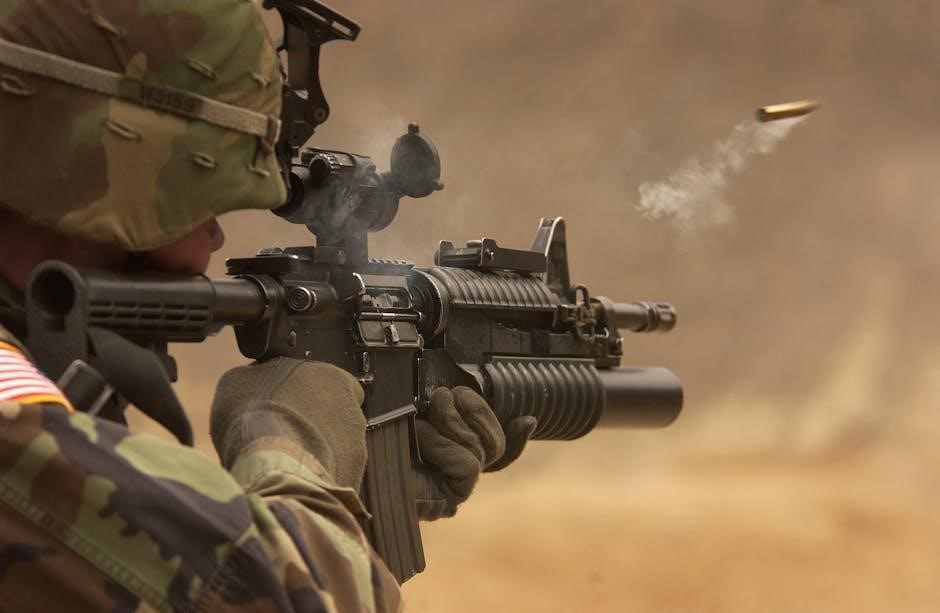4-4 defense blitz packages pdf

Overview of the 4-4 Defense
The 4-4 defense is a balanced scheme with four linemen and four linebackers, designed to stop the run and pass effectively․ It’s popular in youth football due to its simplicity and versatility, requiring fewer elite players․ This formation excels at stacking the box and provides a strong base for blitz packages and coverage options, making it adaptable for various offensive formations․

Philosophy and Base Alignment
The 4-4 defense emphasizes simplicity and physicality, focusing on stopping the run and pressuring the quarterback․ Its base alignment features four defensive linemen and four linebackers, creating a balanced front․ The philosophy revolves around stacking the box to neutralize run plays while maintaining flexibility for blitz packages․ The defensive linemen typically align in 1-technique or 3-technique, allowing linebackers to fill gaps aggressively․ This setup is ideal for teams with average athleticism, as it relies on sound fundamentals rather than speed or complexity to succeed․
Key Positions and Responsibilities
In the 4-4 defense, the four defensive linemen are responsible for occupying blockers and controlling the line of scrimmage․ The linebackers, often the stars of the scheme, must read keys quickly and fill gaps or blitz․ Outside linebackers are typically athletic and versatile, handling edge containment and pass rush․ The secondary provides deep support, with safeties often serving as the last line of defense․ Each position requires disciplined execution to maintain gap integrity and disrupt offensive plays effectively․
Advantages of the 4-4 Defense
The 4-4 defense offers simplicity and versatility, making it ideal for teams with limited personnel․ It excels against the run by stacking the box with eight defenders near the line; The scheme allows for aggressive blitz packages, creating pressure on the quarterback․ Its balanced alignment makes it adaptable to various offensive formations․ Additionally, it requires fewer elite athletes, making it accessible for youth and developmental teams․ This flexibility and effectiveness explain its popularity across all levels of football, from youth leagues to professional leagues․
Blitz packages are strategic rushing schemes in the 4-4 defense, employing linebackers to pressure the quarterback and disrupt offensive plays effectively․
Definition and Purpose
A blitz package is a defensive tactic in the 4-4 scheme where extra defenders rush the quarterback to create pressure․ Its primary purpose is to disrupt the offense by forcing quick decisions, leading to sacks or turnovers․ Blitzes target specific gaps in the offensive line, such as A, B, or C gaps, and involve linebackers and defensive linemen․ This aggressive strategy aims to exploit weaknesses and limit the quarterback’s time to execute plays effectively․
Common Blitz Strategies
Common blitz strategies in the 4-4 defense include A-gap, B-gap, and edge blitzes․ A-gap blitzes target the center-guard gaps to pressure the quarterback quickly․ B-gap blitzes attack the guard-tackle gaps, disrupting pass plays․ Edge blitzes involve linebackers rushing from the outside to contain runs and pressure the QB․ These strategies aim to exploit offensive line weaknesses and create chaos in the backfield, forcing the quarterback into hurried decisions and potential turnovers․
Blitz Packages vs․ Base Defense
Blitz packages differ from base defense by adding extra pressure on the quarterback․ Unlike the base 4-4 defense, which focuses on stopping the run and covering zones, blitz packages involve sending additional defenders to rush the quarterback; This creates immediate pressure and disrupts the offense’s timing․ While the base defense relies on coverage and containment, blitz packages prioritize aggression and forcing quick decisions․ However, blitzing can leave vulnerabilities in coverage if not executed precisely, requiring careful balance between pressure and protection․

Blitz Package Fundamentals
Blitz packages in the 4-4 defense are built on speed and precision․ They involve coordinated rushes from linebackers and linemen to overwhelm the offense․
Gap Blitzing (A, B, and C Gaps)
Gap blitzing in the 4-4 defense targets specific offensive line gaps․ The A-gap is between the center and guards, the B-gap between guards and tackles, and the C-gap outside the tackles․ Blitzers attack these gaps to disrupt plays, with linebackers often exploiting the A and B gaps to pressure the quarterback․ Defensive linemen may slant or angle to create penetration, while edge blitzers target the C-gap to contain the run and rush the passer effectively․

Linebacker and Defensive Line Roles
In the 4-4 defense, linebackers are key blitzers, often attacking through A or B gaps to pressure the quarterback․ They may spy the QB if he’s a run threat․ Defensive linemen occupy blockers, freeing linebackers to blitz․ Techniques like slanting or angling help linemen penetrate gaps, while linebackers’ speed and agility enable them to exploit offensive weaknesses․ Their coordinated roles create disruptive pressure, essential for effective blitz packages․

Timing and Execution
Timing is crucial for successful blitz execution in the 4-4 defense․ Linebackers must read the snap count and explode through their assigned gaps simultaneously․ Defensive linemen slant or stunt to clear paths, ensuring blitzers are unblocked․ Execution relies on precise communication and trust among players․ Coaches emphasize rehearsed timing to avoid overpursuit, which can leave vulnerabilities․ Proper execution disrupts the offense’s rhythm, forcing quick decisions and potential turnovers․

Specific Blitz Types
The 4-4 defense employs A-gap, B-gap, and C-gap blitzes to target specific offensive line weaknesses․ Edge blitzes add pressure from the outside, enhancing defensive versatility․
A-Gap Blitz
The A-gap blitz targets the area between the center and guards, creating immediate pressure on the quarterback․ Linebackers or defensive linemen explode through these gaps to disrupt running plays and force quick throws․ This aggressive pressure is particularly effective against offenses relying on inside runs or quick pass sets․ The A-gap blitz is a cornerstone of the 4-4 defense, utilizing speed and timing to exploit offensive line weaknesses and disrupt rhythm․
B-Gap Blitz
The B-gap blitz focuses on the area between the guards and tackles, often involving linebackers or defensive ends․ This blitz is designed to disrupt off-tackle runs and delay the quarterback’s decision-making․ By attacking the B-gap, defenders can collapse the pocket and force the quarterback into hurried throws or sacks․ The B-gap blitz is a versatile tactic that complements the 4-4 defense’s aggressive nature, leveraging speed and precision to outmaneuver blockers and create chaos in the backfield․
C-Gap Blitz
The C-gap blitz targets the area outside the tackles, typically involving edge rushers or linebackers․ This blitz is effective against sweep plays and off-tackle runs, forcing the ball carrier to cut back inside․ The C-gap blitz also pressures quarterbacks on bootlegs and rollouts, limiting their escape routes․ By sealing the edges, defenders can funnel the play toward interior defenders, enhancing the defense’s ability to contain and tackle effectively․ This tactic is particularly useful in aggressive schemes aiming to control the perimeter and dictate the flow of the offense․
Edge Blitz
The edge blitz involves sending linebackers or defensive ends from the perimeter to pressure the quarterback․ This tactic is designed to disrupt pass plays and contain run plays by sealing the edges․ Edge blitzers often target the C-gap, forcing the quarterback to make quick decisions․ Effective execution requires coordination with interior defenders to prevent gaps․ This blitz is particularly effective against offenses relying on edge blocking and play-action passes, as it limits the quarterback’s ability to escape and extend plays․ Proper timing and leverage are crucial for success in an edge blitz scheme․

Zone Coverage in Blitz Packages
Zone coverage in blitz packages divides the field into areas covered by defenders, allowing them to protect spaces while blitzers pressure the quarterback, creating a balanced defensive strategy․
Overview of Zone Coverage
Zone coverage in the 4-4 defense is a strategic approach where defenders protect specific areas of the field rather than individual receivers․ This allows for better situational awareness and support during blitz packages, ensuring gaps are covered while pressuring the quarterback․ Zone schemes like Cover 3 and Cover 4 divide the field into zones, with defenders assigned to specific areas․ This approach provides flexibility, enabling defenders to react to the play while maintaining coverage integrity, making it a critical component of the 4-4 blitz strategy․
Cover 3 and Cover 4 Schemes
Cover 3 and Cover 4 are cornerstone zone schemes in the 4-4 defense, balancing blitz pressure with pass coverage․ Cover 3 divides the field into three zones, with the safety providing deep support․ Cover 4 splits it into four, offering robust protection against deep passes․ Both schemes allow linebackers to blitz while the secondary maintains coverage discipline․ These schemes are versatile, adapting to various offensive threats while ensuring the quarterback faces consistent pressure and limited passing windows, making them integral to the 4-4 defense’s effectiveness․
Combining Blitz and Coverage
Combining blitz and coverage in the 4-4 defense requires precise coordination between linebackers and the secondary․ Blitz packages are designed to pressure the quarterback while maintaining zone coverage to protect against deep passes․ Linebackers blitz through specific gaps, and defensive backs adjust their coverage accordingly․ This strategy ensures balanced pressure and protection, preventing offenses from exploiting vulnerabilities․ Timing and execution are critical, as miscommunication can lead to big plays․ The 4-4 defense excels at blending aggression with coverage discipline, making it versatile against various offensive schemes․
Strengths of the 4-4 Blitz Packages
The 4-4 blitz packages are aggressive, flexible, and effective against both run and pass․ They utilize linebackers and defensive linemen to pressure the quarterback and disrupt plays․
Pressure on the Quarterback
The 4-4 defense excels at generating pressure on the quarterback through blitz packages․ By sending linebackers and defensive linemen from various gaps, such as A, B, and C gaps, it disrupts offensive timing․ This aggressive approach forces quick decisions and often leads to sacks or interceptions․ The flexibility of the 4-4 scheme allows for multiple blitzing strategies, keeping offenses guessing and creating consistent pressure․ Effective pressure on the quarterback is a cornerstone of the 4-4 defense’s success in both youth and professional levels of play․
Flexibility in Defensive Schemes

The 4-4 defense offers exceptional flexibility, enabling teams to adapt to various offensive strategies․ Coaches can seamlessly transition between blitz packages and base defense, keeping offenses guessing․ This scheme allows for multiple adjustments, such as gap blitzing and edge pressures, without altering the base formation․ Its adaptability makes it effective against both run-heavy and pass-oriented offenses, providing a versatile toolkit for defensive coordinators at all levels of play․ This flexibility is a key reason the 4-4 remains a popular choice in modern football strategies․
Stopping the Run and Pass
The 4-4 defense excels at stopping both the run and pass by combining a strong front and aggressive blitz packages․ The four-man line effectively occupies blockers, freeing linebackers to flow to the ball․ Blitzes targeting specific gaps disrupt run plays and pressure quarterbacks, while zone coverages behind the blitz ensure pass defense․ This balanced approach makes the 4-4 defense highly effective against diverse offensive strategies, consistently disrupting both running and passing attacks with precision and speed․
Challenges and Weaknesses
The 4-4 defense can struggle against offenses with elite speed and precise timing, exploiting its reliance on linebacker agility and gap integrity․ Vulnerable to big plays if blitzes miss or coverages fail, it demands precise execution to avoid yielding explosive gains, particularly when facing dynamic quarterbacks and receivers who thrive on mismatches and breakdowns in coverage․
Vulnerability to Specific Offensive Plays
The 4-4 defense can be vulnerable to offensive plays that exploit its aggressive nature, such as screen passes and draws․ Quick slants and misdirection runs can also challenge linebackers’ ability to diagnose plays quickly․ If blitzes are timed incorrectly, offenses can capitalize with deep passes or running lanes․ Additionally, offenses using speed sweeps or stretch plays can target the edges, where the 4-4’s focus on interior pressure may leave defensive ends isolated and overmatched by faster ball carriers․
Dependence on Linebacker Speed
The success of the 4-4 defense heavily relies on the speed and agility of its linebackers․ Fast linebackers are crucial for effectively blitzing through gaps and covering receivers in zone schemes․ Slow linebackers can be exploited by offenses, leading to big plays․ Their ability to quickly diagnose plays and react is vital for maintaining defensive integrity and applying pressure on the quarterback․ Without athletic linebackers, the defense’s effectiveness diminishes, making it harder to stop both the run and pass․
Potential for Big Plays by the Offense
The 4-4 defense’s aggressive nature can leave it vulnerable to big offensive plays, particularly when blitzes are overcommitted․ Offenses often exploit this by using play-action passes or deep routes to target single-coverage situations․ If the blitz fails to pressure the quarterback, receivers can find open spaces, leading to significant gains․ Additionally, offenses may attack gaps created by blitzing linebackers, turning screen passes or draw plays into large chunks of yardage․ The defense must balance aggression with coverage to minimize these risks and prevent explosive offensive plays․
Game Planning and Adjustments
Coaches analyze offensive tendencies, adjust blitz packages, and use film study to anticipate formations․ Flexibility and smart in-game adjustments are crucial for maintaining defensive effectiveness and countering offensive strategies․
Reading Offensive Formations
Reading offensive formations is critical for aligning the 4-4 defense effectively․ Coaches study tendencies, such as tight end positioning or receiver splits, to anticipate plays․ Identifying strengths, like a powerful run game or a pass-heavy offense, helps tailor blitz packages and coverage․ Formation adjustments, such as single-back or trips sets, signal specific threats, allowing defenders to align accordingly․ This preparation enables the defense to counter offensive strategies proactively, maximizing the impact of blitzes and coverage schemes․ Proper reads ensure the defense is one step ahead, enhancing overall performance․
Adjusting Blitz Packages During the Game
Adjusting blitz packages during the game is essential for maintaining defensive effectiveness․ Coaches analyze the offense’s tendencies and adjust blitz timing and angles to exploit weaknesses․ If the offense counters with screens or quick passes, blitzes may shift to contain edges or pressure from different gaps․ Real-time adjustments ensure the defense remains unpredictable, keeping the offense guessing․ This adaptability is key to disrupting rhythm and forcing turnovers, making the 4-4 defense versatile and formidable in dynamic game situations․ Effective in-game adjustments enhance the defense’s overall impact․
Using Film Study to Prepare
Film study is crucial for preparing blitz packages in the 4-4 defense․ Coaches analyze offensive tendencies, identifying patterns in play calls and player strengths․ This helps anticipate formations and adjust blitz strategies accordingly․ By studying the opponent’s playbook, defensive coordinators can design blitz packages that exploit weaknesses, such as targeting gaps or pressuring a mobile quarterback․ Film review also aids in refining timing and execution, ensuring players are prepared to disrupt offensive rhythm and create turnovers during the game․ This preparation enhances the defense’s ability to adapt and succeed․
Player Responsibilities in Blitz Packages
Defensive linemen occupy blockers, linebackers blitz through designated gaps, and the secondary provides coverage support․ Each player’s role is critical to execute the blitz effectively and maintain defensive integrity․
Defensive Line Techniques
The defensive line in a 4-4 scheme focuses on occupying blockers and creating pressure․ Techniques include slanting, angling, and rushing to disrupt the offensive line․ Linemen must be athletic and disciplined to execute these techniques effectively, ensuring they maintain gap integrity while applying pressure on the quarterback․ Proper hand placement, footwork, and leverage are critical to overpower blockers and create chaos in the backfield․ Their role is vital in setting the tone for the defense and enabling linebackers to blitz successfully․
Linebacker Assignments
Linebackers in the 4-4 defense are pivotal in executing blitz packages and maintaining defensive integrity․ Their primary roles include gap blitzing, man-to-man coverage, and containing the run․ They must read offensive formations quickly, adjust to play calls, and deliver pressure on the quarterback․ Linebackers often spy mobile QBs and fill gaps in the run defense․ Their speed and agility are critical in disrupting plays and supporting both the defensive line and secondary․ Proper assignments ensure effective execution of blitz schemes and overall defensive success․
Secondary Support
The secondary plays a crucial role in supporting blitz packages by providing coverage and ensuring receivers are contained․ Cornerbacks and safeties must read the quarterback’s eyes and react quickly to potential passes․ Deep support is essential to prevent big plays, while man-to-man coverage on receivers allows linebackers to blitz freely․ Open communication between linebackers and defensive backs ensures seamless coordination, with safeties often providing help over the top․ This balance between pressure and coverage is vital for the defense’s success in disrupting offensive rhythm and limiting scoring opportunities․

Real-World Applications
The 4-4 defense is widely used in youth football, colleges, and the NFL, offering simplicity and effectiveness․ Coaches adapt it to suit various skill levels and strategies․
Use in Youth Football
The 4-4 defense is highly popular in youth football due to its simplicity and effectiveness․ It allows teams to field competitive defenses without requiring elite talent․ Coaches can easily teach blitz packages and zone coverage schemes, making it ideal for developing fundamental skills․ The 4-4’s balanced alignment and aggressive nature help youth teams counter common offensive formations․ Its versatility enables coaches to adapt the scheme to their players’ strengths, fostering teamwork and strategic play․ This makes the 4-4 a cornerstone for building strong defensive foundations in young athletes․
Collegiate and NFL Examples
The 4-4 defense is utilized at collegiate and NFL levels for its adaptability and effectiveness․ College programs often employ it to counter dynamic offenses, while NFL teams incorporate it into their defensive arsenals for specific matchups․ Teams like the Baltimore Ravens have successfully used 4-4 blitz packages to pressure elite quarterbacks․ Its versatility allows coordinators to tailor the scheme to exploit offensive weaknesses, making it a valuable component in advanced defensive strategies at higher levels of competition, where strategic complexity and player athleticism are paramount․
Success Stories and Case Studies
The 4-4 defense has proven effective in various success stories․ The Baltimore Ravens famously used aggressive 4-4 blitz packages to dominate offenses, showcasing its potential․ A high school team adopted the 4-4, reducing opponents’ scoring by 40% through strategic blitzing․ Wisconsin’s defense thrived with timing and technique, highlighting the scheme’s adaptability․ These examples demonstrate how the 4-4 defense, when executed correctly, can lead to significant defensive improvements and victories at all levels of competition, making it a reliable choice for coaches seeking a balanced and aggressive approach․

The 4-4 defense is a reliable choice for teams seeking balance and aggression․ Its versatility in blitz packages and adaptability to various levels make it a proven strategy․
The 4-4 defense is a versatile scheme featuring four linemen and four linebackers, ideal for stopping the run and pressuring quarterbacks․ Its simplicity makes it suitable for all skill levels, while blitz packages add aggression and disrupt offenses․ Zone coverage options like Cover 3 and 4 enhance flexibility․ Athletic linebackers are crucial for execution․ This defense balances strength against the run and pass, making it a popular choice for youth, collegiate, and professional teams seeking adaptability and strategic advantages․
Final Thoughts on the 4-4 Blitz Packages
The 4-4 blitz packages offer a dynamic and aggressive approach to defensive strategy, making them highly effective in pressuring quarterbacks and disrupting offenses․ Their versatility allows teams to adapt to various offensive schemes, while the simplicity of the base 4-4 defense makes it accessible for teams at all skill levels․ When executed properly, these blitz packages can be a game-changer, balancing run-stopping ability with pass-rush intensity․ They are a valuable tool for coaches seeking to maximize defensive impact and control the flow of the game․